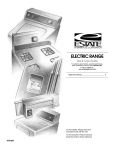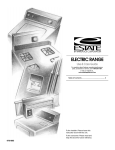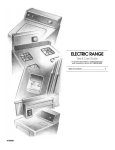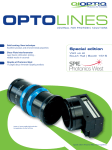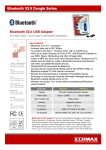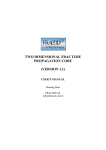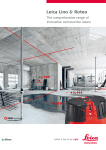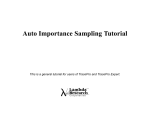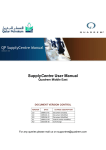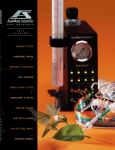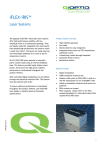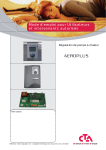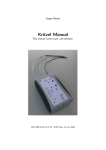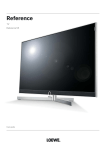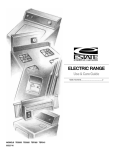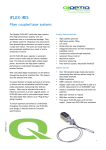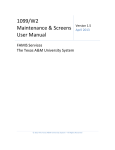Download pdf
Transcript
OPTOLINES JOURNAL FOR PHOTONIC SOLUTIONS Qioptiq Shop goes online Easy ordering, secure purchasing Tailored coating solutions Job coating: The quick way to your coated optics 11-page trad e show speci al on product in novations! Nano series 250 Higher performance, new wavelengths Compact USB spectrometer for all applications: Exceptional specifications | Seite 4 No. 27 | 2011 2 Editorial Content Innovas Compact USB spectrometer for all applications: Exceptional specifications | Page 4 LASER special LASER World of Photonics – 11-page special report Product news | Pages 6 – 16 Dear Readers, This latest issue of optolines, our customer journal, is filled with the innovations we will be presenting at the LASER World of Photonics trade show in Munich. The 11-page Trade Show Special Report gives you an advance look at the extensive range of products and services we offer, so you will be able to ask very specific questions. The experts at our trade show booth can tell you all about the photonics solutions available from Qioptiq. We will be happy to consult with you! The LINOS catalog of products is one example of a focal point at our Research & Development market segment. The products in the LINOS catalog range from Microbench structures to LED cold light sources; from extremely small and powerful spectrometers to achromats and shear plate interferometers. Our new Qioptiq Shop is a milestone in excellent customer service. Its online debut is scheduled to coincide with the trade show. We have optimized the format and content of the shopping site to combine the convenience of state-ofthe-art online services, fast and targeted menu navigation, and the greatest possible customer benefit in the search for special products and tailored solutions. Our trade show slogan is: ”Take your innovation to new heights.” Take advantage of the upward swing in the economy and fortify your market position with Qioptiq product innovations and solutions. I hope you enjoy reading this issue! Best regards, Volker Brockmeyer Qioptiq Executive Vice President Photonic Systems Division Service Job coating: Tailored coating solutions – the quick way to your coated optics | Page 17 Innovas Light sources for the LINOS Nanobench: Miniaturized laser modules in the NANO 100 Series | Page 20 Innovas Higher performance, new wavelengths: New NANO 250 Series | Page 21 Innovas Vacuum-compatible worktops: Optical tables in the 730 Series for high vacuum | Page 22 Start-up The new Qioptiq Shop is online! | Page 23 Applications Sapphire windows and sapphire domes: Rugged, very resilient and much in demand | Page 24 Innovas Glass melts: High-tech from Qioptiq in orbit | Page 26 Innovas New range of lamps from Qioptiq: Universal housing with models for halogen, Xenon and mercury vapor lamps | Page 28 Application Image stabilization + autofocus = Baltic 617: Miniature liquid lens, electro-optically controlled | Page 30 Basics Wavefront coding with real potential for success: The first Qioptiq demonstration of computer-aided imaging systems | Page 32 Qioptiq Live Trade show retrospectives – Trade show calendar – Recommended reading No. 27 | 2011 optolines Insight Qioptiq: From medical science to research at LASER Discover the Q! A large green Q-gate towers over the Qioptiq trade show booth in Hall B1, 107 and invites visitors to come in and learn all about the diverse Qioptiq range for medical and life sciences, industrial manufacturing, defense and aerospace, and research and development. LINOS Catalog Products Precision optics and mechanics from LINOS will be available here for hands-on demonstrations and up-close interaction, from LINOS Microbench structures to the new LED cold light sources; and from extremely small, high-performance spectrometers to LINOS achromats and shear plate interferometers. Coatings The Qioptiq coating experts will also be on hand to discuss the possibilities and special features that coatings can offer. Our selection of coatings extends from sophisticated edge filters for deep UV to super-broadband anti-reflective coatings in the visible spectral range, and even to gold coatings for far infrared. Defense & Aerospace In the Defense and Aerospace sector we‘ll offer a glimpse into the world of image intensifiers and thermal-imaging equipment for soldiers. We will also be showing complex optical modules and components developed and manufactured for a variety of military and secu- rity applications. These cover a wavelength range beginning in UV (solar blind) for missile warning applications and extending into the IR range (8 – 12 µm) for seeker head and camera modules. HUDs and HMDs for air-supported reconnaissance and warning systems complete the product line. Industrial Manufacturing The Industrial Manufacturing division will exhibit new motorized, adjustable beam expanders and NIR lenses, used for example in microcrack detection and in photoluminescence and electroluminescence. For our Lasers and Laser Systems customers, the Vision Technology Division will present new NIR lenses for solar cell inspection and for applications in the food and pharmaceuticals sectors, as well as high-resolution lenses in the inspec.x L series. Our magneto- and electro-optical products range from compact Faraday isolators to new laser modulators, to Pockels cells for 250 nm – 3 µm. Both standard and customer specific solutions are offered in this field. Medical & Life Sciences In the Medical and Life Sciences sector we will present the smallest video camera in the world, the open setup of a fundus camera, high-performance X-ray lenses, a laser scalpel and a dental camera with a completely new autofocus liquid lens. An iFLEX Viper multi-wavelength laser engine with a modular single-mode fiber The Qioptiq Trade Show Team looks forward to seeing you! (Photo: Optatec 2010 trade show in Frankfurt). coupler will also be on display. The Qioptiq program at the LASER is rounded out by a number of talks to be given at the World of Photonics Congress. Win a Q-Kite This year‘s Qioptiq contest challenges you to deflect a laser beam, using LINOS components, so that the beam hits the Qioptiq Q. All winners will receive a fantastic Qioptiq stunt kite! For more details on our trade show program, see the Special Report starting on page 6. Online Shop Qioptiq presents its new online shop: www.qioptiq-shop.com Qioptiq Regen: Promoting young academics Johannes Blümel is the first student to be supported by photonics specialist Qioptiq with the new ”Germany Grant” from the German government. The program, co-financed by the federal government and private sponsors, supports outstanding students with a monthly grant of EUR 300 and gives them an important opportunity to see the business world up close. At Qioptiq, for example, No. 27 | 2011 optolines students can do fascinating internships or write their bachelor‘s theses. Both the budding engineering scientists and the company benefit from the experience: ”With our high-tech product line, we need highly qualified specialists,” explains Max Tanzer, human-resources director at Qioptiq in Regen. ”Ideally, we hope to be promoting future Qioptiq employees with the Qioptiq/Germany Grant.” Sonja Kellerer, human-resources officer at Qioptiq in Regen, was on hand when Johannes Blümel received the grant. 3 4 Innovas Compact USB spectrometer: Exceptional specifications Spectrometer for all applications In a housing hardly bigger than a deck of cards, the new Qwave spectrometer achieves high resolution, sensitivity and stability, making it ideal as a universal spectrometer for a variety of applications. The spectrometer is controlled and its data downloaded using a PC, with operating software that is unique throughout the world for its user-friendliness and high performance. Unique software The spectrometer is controlled using the ”Waves” program, included in delivery, which not only uses advanced algorithms for measurement and evaluation, but also makes these functions easily accessible in its clearly laid out, intuitive user interface. Many of the measurement and analysis features are available at a single mouseclick. With Qwave, the dark spectra for optimum sensitivity no longer have to be recorded anew every time the exposure time is changed. Instead, a number of automatically recorded dark Software features Import spectra as ASCII files Hardly bigger than a deck of cards: The new Qwave spectrometer. With a focal length of 75 mm, the Qwave attains specifications normally seen only in much larger spectrometers. In the standard version, it offers a resolution of 0.5 nm and covers a wide spectral range from 350 nm to 950 nm. The range can be configured anywhere between 200 nm and 1100 nm to meet customer require- ments. The narrower the spectral range, the higher the resolution. Furthermore, the instrument is distinguished by high sensitivity, a signalto-noise ratio of 2000:1 (at 1 second exposure time) and excellent thermal stability in a temperature range from -15 to +60 °C. Export spectra as ASCII files for further evaluation with Origin, Excel or other programs Calculation of statistical values Print the diagrams and export them as PDFs Dynamic peak finder (no threshold setting necessary) Automatic wavelength calibration Colorimetry Software developers‘ kit for customizing the spectrometer control program No. 27 | 2011 optolines Innovas spectra are stored as calibration values and interpolated. In conjunction with the automatic lighting control and the calibration of the wavelengths and spectral sensitivity, a single mouseclick is all that is needed to record a spectrum with the highest possible accuracy. Furthermore, several spectra can be recorded, displayed and compared. The strip chart function enables graphic display of a variety of characteristics of these spectra, which can be very useful for analyzing transients, for example. The complete software package, including drivers and updates, is included in delivery of the spectrometer. Contact: [email protected] Specifications, Qwave UV/VIS/NIR Focal length 75 mm Numerical aperture 0.10 Spectral range From 350 nm to 950 nm (standard)* Grid 600 lines / mm** Entrance slit 20 µm (other size on request) Spectral resolution 0.5 nm (for 350 nm to 950 nm) Signal-to-noise ratio From > 2000 : 1 (texp = 1 s) Scattered light < 0.05 % Exposure time 0.1 ms to 600 s CCD line sensor 3648 pixels 16 bit 15 MHz A/D converter SMA connector For optic fiber (other on request) USB 2.0 interface The complete ”Waves” software suite is included in delivery. External connections For trigger, shutter and light sources Dimensions 89.5 mm x 68.0 mm x 19.5 mm Weight 155.4 g Operating temperature -15 °C to +60 °C (non-condensing) Storage temperature – 25 °C to 70 °C Power consumption 5 V DC, 500 mA (over USB) Software Windows 7/Vista/XP compatible Order no G12 0585 000 Price 2395,– *** * Other ranges possible, within 200 nm t o 1100 nm ** Other grids available on request *** Sales tax not included; price valid in Germany and Austria No. 27 | 2011 optolines 5 6 Laser Special Innovate to New Heights! Gold coating New technique developed Coatings for applications in the near and mid-infrared spectral range have been a core competency at Qioptiq in Göttingen for more than 40 years. Gold coating is a major area of focus in this field. Now, Qioptiq has developed a new gold coating technique that significantly improves both the product properties and the environmental properties of the gold layer. Protecting the metal with a thin dielectric coating is one way to increase environmental stability. In developing their cold-coating technique, Qioptiq has succeeded in ensuring adequate transparency of the dielectric material in the IR range to preserve the advantage of high reflectivity provided by a gold coating. (See also the article starting on page 17.) Liquid lenses LINOS Microbench New generation The time-tested original for optical experimental setups! The new Baltic 617 liquid lens from Varioptic, with variable focus and variable tilt, has been specially developed for both autofocus applications (AF) and for optical image stabilization (OIS). The OIS mode ensures excellent image quality even under extremely poor lighting conditions, which would otherwise result in blurred images. The lens is optimized for chip formats of 1/4” and 1/3”, as well as for larger formats, depending on the f-stop. For more information, please see our detailed article starting on page 30. This compact 4-four-rod system has been mass-produced in Göttingen since 1968. The LINOS Microbench was developed by Spindler & Hoyer as an innovative successor to the triangular profile system for optical experimental setups. Microbench is a compact component system for numerous areas of application. Its outstanding characteristics include high mechanical stability and remarkable ease of use – even for first-time users. Exceptional flexibility is ensured by the wide variety of components available for LINOS Microbench systems, the range of adjustment elements and by the system‘s modular design. The Microbench system is as simple as can be! It is based on just a few construction elements: mounting plates, holders and cubes. These components are used to mount the optics, and are connected with rods to form very compact and stable units. To make the Microbench system even easier and more convenient to use, we have now developed a new adjusting aid for simple adjustment of the beam path. The adjusting aid is made of anodized aluminum with a 1 mm-bore hole on the optical axis and a reticle imprinted on one side. No. 27 | 2011 optolines Laser Special Hall B1 | Booth 107 Discover the Qioptiq World! New motorized, variable beam expander 2 – 8 x: faster, more precise, more compact With the motorized beam expander for variable expansion and divergence, the spot size (power density) and processing level/processing position parameters can be modified quickly in component processing. Parameter changes can also Motorized beam expander for 355, 532, 642 and 1064 nm Diameter, input beam (1/e²): 8 mm max. Diameter, output beam (1/e²): 32 mm max. Adjustment time, min-max: < 5 sec Pointing stability: < 0.5 mrad Interfaces: RS-232, USB Product number: 4401-502-000-21 (532 nm) 4401-503-000-21 (1064 nm) be programmed. Semiconductor manufacturing provides a practical example: This application involves etching wafers to various depths, while maintaining a 1 μm uniformity of depth. The expander can be used to adjust the power density precisely by adjusting the spot size, for example, while the beam source continues uninterrupted. For wafers of various thickness, the focal position can be modified by adjusting the divergence. Calendar The Qioptiq brochure Mon., 23 May, 3:30 – 4:00 pm Coating Panel Talk by Dr. Tobias Nowitzki See page 16 ”LINOS products: News & Highlights 2011” This year, Qioptiq will not be publishing a new printed version of the LINOS catalag. ”Last year, we decided to print a 2010/2011 catalog so that we could concentrate our energies on a comprehensive relaunch of the online shop this year,” explains Christoph Fries, head of the Catalog business unit. ”Now we are very pleased to present the new Q-Shop: an all-new shopping and information platform tailored to your needs. Point your browser to www.qioptiq-shop.com to experience the new Q-Shop!” The latest products from LINOS are presented not only in the new online forum, but also in a ”hands-on” printed brochure from Qioptiq. The new brochure, making its debut at the LASER trade show, is called ”LINOS Products: News & Highlights 2011.” It contains 48 pages of product innovations for 2011 in the optics, mechanics and electro-optics areas, as well as instruments and light sources, with a wealth of information on highlighted products. And, by the way: The latest WinLens 3D software comes with the brochure! Interested? Come to the Qioptiq booth in Hall B1, Booth 107, where your brochure with the WinLens CD is waiting for you! Wed., 25 May, 2:00 – 3:30 pm Application Panel Talks by Steve Rickard, Ulf Krause, Dr. Mario Münzberg Lecture forum: Hall B2 | Booth 421 WinLens ™ 3D Hall B1 | Booth 107 html WinL ens ™ DESI 3D GN SOFT Catalo WAR g 2010/2 E 011 | Bro chures www.q iop www.q tiq-shop.co m ioptiq .com mb H CAL sch lan dG OPTI No. 27 | 2011 optolines ld in g De ut LINOS © TI Q OP QI Ho Come and see us! 7 8 Laser Special Innovate to New Heights! F-Theta Lenses made of quartz Qioptiq has a new telecentric quartz lens with a focal length (FL) of 100 mm for UV applications (343 nm to 355 nm). Three other newly developed scan lenses made of fused silica cover wavelengths 515 nm to 540 nm with FL 255 mm and wavelengths 1030 nm to 1080 nm, with FL 255 mm and 420 mm. The fused silica minimizes NIR lenses Excellent transmission Qioptiq now offers new versions of the familiar MeVis-C and Rodagon lenses for the wavelength range of 900 nm to 1400 nm. Due to the low sensitivity of CCD chips in the NIR range, it is essential to collect the maximum possible amount of light on the sensor. Standard lenses optimized for the visible spectrum are suitable only to a limited extent for this task, with transmission in the NIR range often below 70%. Qioptiq offers special lenses with excellent transmission of up to 98% in this exceptional wavelength range. The lenses are well suited for the following applications: Microcrack detection Photoluminescence Electroluminescence focus shift while providing high power density. The optical designs are analyzed with respect to back reflection of the input beam, which significantly reduces the risk of damage to the galvo mirrors. The lenses are all treated with a broadband Order no. 4401-509-000-21 4401-496-000-21 4401-499-000-21 4401-508-000-21 coating, making them suitable for a wide variety of lasers. These diffraction-limited lenses are all mounted using patented technologies to ensure long-term optical stability even under unfavorable ambient conditions. Wavelength Focal length Input beam Spot Ø Scan field nm mm Ø mm µm mm x mm 343 - 355 515 - 540 1030 - 1080 1030 - 1080 100 tc* 10 255 10 255 10 420 14 7 25 50 60 45 x 45 170 x 170 170 x 170 254 x 254 *tc: telecentric FETURA Vision Metrology System expands multi-sensor design Optical coordinate measurement technology has become an integral part of the manufacturing industry. Now, Qioptiq presents a multi-sensordesign that achieves greater flexibility: In addition to the optical zoom system and the Keyence laser sensor, the Fetura VMS is also available with tactile 3D probes from Renishaw. Most characteristics of measured objects can be tested quickly using optical methods. Features such as undercuts or lateral bore holes, however, are not detected. The built-in 3D probe now enables complete dimensioning of the entire component. The three sensors are supported by the FETURA VMS PowerMetrix software. The open design of this software makes the FETURA VMS measuring machine ideal for integration in automated production. At the Qioptiq booth in Hall B1, Booth 107, you can see the FETURA ”live” and in action. You can bring a test object of your own – our FETURA Team will be happy to measure it! For more information: www.fetura.com No. 27 | 2011 optolines Laser Special Hall B1 | Booth 107 Discover the Qioptiq World! Shear plate interferometer Simple collimation testing The new shear plate interferometers from Qioptiq make it easy to check the collimation of laser beams. The quality of collimation is visualized in real time in the beam path. The interferometer is available in three versions for beam diameters of 1 mm to 25 mm, and its wedge-shaped shear plate is constructed with maximum accuracy. It is designed with a number of different installation options for easy integration into various experimental setups. An adapter plate is also available for compatibility with LINOS Microbench, Nanobench and the Tube-C systems. Outstanding features of the new shearing interferometer include: Compact design Easy operation Robustness Common path interferometry No electronic parts Wavefront sensor system SHSLab BR-110-GE-STD The SHSLab BR-110-GE-STD wavefront sensor system from Optocraft, distributed by Qioptiq, is a universal tool for optical laboratories and industrial laser technology. It features high stability, and its speed and ruggedness open up new possibilities in research, quality assurance and the development o f optical and laser-based systems. The sensor head ensures high accuracy for laser beam characterization and optics testing, as well as for LED light sources. The sensor head has a lateral resolution of 58 x 43 microlenses, a camera with 12-bit gray scale resolution and a state-ofthe-art gigabit Ethernet interface. The sophisticated and reliable analysis software ensures optimum use of the high-quality sensor head. It features an extremely dynamic range in wavefront measurement for tilt, sphere and higher aberrations, and enables not only reconstruction of the wavefront, but also has extensive functions for calibration, automatic parameter selection, progressive evaluation and data export. The SHSLab BR-110-GE-STD is distributed by Qioptiq in many countries, effective immediately. No. 27 | 2011 optolines TracePro® Optical analysis software Discover the Tr a c e P r o ® optical analysis software: Dave Jacobsen, TracePro® applications expert at LambdaResearch, will be at the Qioptiq booth to present the latest features in this leading optical analysis software – for example, the new interactive optimizer. See for yourself how easy it is to design even complicated models with a variety of material and surface properties, and to define different types of light sources. Experience a live demonstration of the versatile tools placed at your disposal by TracePro® for analyzing the results of ray tracing. Dave Jacobsen and the Qioptiq Team are looking forward to consulting with you at the Qioptiq booth! 9 10 Laser Special Innovate to New Heights! Luma XSystem New camera for X-ray technology X-ray diagnostics can provide detailed images and video sequences from inside the body. Qioptiq is the world‘s leading supplier of imaging systems in the field of fluoroscopy. The new Luma X-System features an extremely flat design, thanks to improved system components. The Luma X-System is the heart of a new X-ray detector, and consists of an extremely compact-design lens, the LumaGon, and a flat X-ray camera, the LumaCam. Its modern, 1 megapixel CCD sensor replaces a predecessor that cost almost twice as much. The LumaCam is the first X-ray camera in the world equipped with a powerful GigE Vision interface. NIR beam-splitter cube Now for the near-infrared range, too Effective immediately, the proven beam-splitter cubes with edge lengths from 5 mm to 40 mm are also available in a version for the near-infrared range. ments in the range from 700 nm to 2000 nm and for various directions of polarization. In addition to the standard 50:50 split, customized versions with division ratios of 40:60, 20:80 and 10:90 can be supplied on short notice. These economical and high-quality optics for low laser output are ideal for splitting and combining light beams and, unlike beam-splitter plates, do not cause any deflection of the beam. The layered design of this cube is optimized for the wavelength range from 750 nm to 1200 nm. On request the coating can be adapted to individual require- Structured illumination microscopy Affordable alternatives to confocal imaging With this new development, Qioptiq has managed to add yet another highlight to what was already the world‘s largest range of products. Researchers in the biomedical sciences are constantly seeking innovative imaging techniques for more detailed visualization of intra- and intercellular features of biological samples. Structured illumination microscopy from Qioptiq creates very sharp, highcontrast images that approach the clarity of images created using confocal techniques. When imaging with structured illumination, both random noise and any information from outside the focal plane are filtered out using a system integrated in a conventional wide field microscope and a desktop PC: the OptiGrid imaging system. This structured illumination system combines the versatility of wide field microscopy, using gentle illumination, with low acquisition costs. Thus OptiGrid presents a useful and economical alternative to confocal microscopy for research. No. 27 | 2011 optolines Laser Special Hall B1 | Booth 107 ™ 3D Discover the Qioptiq World! oldi ng D eutsc hland G m bH WinLens CAL LINOS QIO 3D E WAR SOFT chures 011 | Bro g 2010/2 Catalo © ™ Lens WinDE SIGN OPTI PTI QH html m .co -shop ioptiq .com www.q ioptiq www.q WinLens3D® and PreDesigner® updated Simulating Gaussian beams The properties of Gaussian beams can deviate extremely from the paraxial standard calculations of thin lenses, depending on beam parameters and the optics implemented. This is why the PreDesigner program has been updated. The analysis of Gaussian (laser) beams is now enabled in this free software. The PreDesigner now offers a selection of key parameters and depicts the resulting system in a chart of the beam profile and a table of the relevant characteristics, including the position of the beam waist, the diameter of the beam waist, the divergence angle, Rayleigh lengths, and more. These parameter values can be modified manually or using a slider in the graphic interface, and the parameter changes are calculated in real time. The user can also access a number of other functions: Integration of the effects of the beam quality index, M2 Calculation of the depth of focus Selection of suitable Qioptiq components Live presentation Free tickets to the LASER World of Photonics, available from Qioptiq The LASER World of Photonics 2011 opens on May 23 in Munich – and Qioptiq will be there: Hall B1 | Booth 107. Come to the Qioptiq booth and discover a broad range of new and fascinating products and highlights in our four market segments: Medical & Life Sciences Industrial Manufacturing Defense & Aerospace Research & Development Naturally the Qioptiq Team will be on hand to answer all your questions and discuss your ideas. We cordially invite you to visit us, and look forward to welcoming you at our booth! We would be very happy to send you free tickets for admission to the trade show. Just drop a line to [email protected], and we will send you your personal entry code. See you at the LASER World of Photonics 2011! No. 27 | 2011 optolines Would you like to know more about the new PreDesigner software and the WinLens 3D suite? Come and see us at the LASER in Munich, Hall B1 | Booth 107. Win a Qioptiq-Kite! Innovate to New Heights! 11 12 Laser Special Innovate to New Heights! Dental camera Liquid lens and autofocus technology: A new generation of dental cameras Intra-oral cameras are among the standard equipment on today‘s dental chair units. For dentists, they serve as both communication and marketing instruments. Qioptiq has been developing and manufacturing dental cameras as OEM products for renowned dental equipment manufacturers for more than 15 years. The manual focusing once commonly used has been replaced in the new generation of dental cameras by liquid lenses with autofocus technology. The autofocus solution is extremely rugged and durable, operates unobtrusively within milliseconds and is optimized for the particular conditions of intra-oral use. In short, the dental camera from Qi- optiq features a modern and ergonomic design and impressive specifications with respect to watertightness, ease of maintenance, and ruggedness. Expert talks at the World of Photonics Congress Lasers and photonics in use The World of Photonics Congress integrates a series of application-oriented talks into the LASER program, building a bridge between theory and practice. Areas addressed include production optimization, energy, environment, health and safety. Solutions offered by optical technologies will be presented, and speakers from science and industry will engage in dialog with users of these technologies. The ”Modern optical equipment for soldiers” application panel is supported this year by Qioptiq and co-chaired by Steve Shaw, Executive Vice President, Qioptiq Defense & Aerospace Division, and Dr. Mario Ledig, Vice President of Technology at Qioptiq. The subject matter is highly topical, as soldiers today depend on technical support. Optical aids in particular are indispensable; they facilitate perception of the surroundings, and some can convey additional information as well. The state of the art will be presented, as well as the latest implementations of diverse electro-optical subassemblies, modules and systems for soldiers and security forces. For example, HMDs are used to generate images that are constantly available within the field of vision. Under problematic lighting and security conditions, special optics systems use wavelengths in the NIR and MWIR ranges. Soldiers actively engage with this technology when selecting or illuminating images, or using optotronics for missile guidance. Important characteristics include quality of beam guidance or imaging, ruggedness, fast and easy operation, minimal weight, and economical pricing. There are three speakers on the panel: Steve Rickard Business & Product Development Manager at Qioptiq Ltd., will speak on ”Soldier modernization and the integration of laser capabilities” Ulf Krause Head of Defense Systems at JENOPTIK Defense & Civil Systems, will address the topic of ”Laser Sensors for defense applications.” Dr. Mario Münzberg Head of Imaging Instruments at Carl Zeiss Optronics GmbH, will talk about ”Modern electro-optical sensors for long range observation systems.” Date and time: Wednesday, 25 May, 2011 2:00 – 3:30 pm Hall B2 | Booth 421 No. 27 | 2011 optolines Laser Special Hall B1 | Booth 107 Discover the Qioptiq World! kineFLEX-UV™: Fiber Delivery up to 20mW The new kineFLEX-UV™ is a robust laser beam delivery system from the kineFLEX™ family of products. This fiber delivery technology is designed around pre-focused and integrated optical assemblies; plus it is automatically mode matched to your laser parameters to achieve transmission efficiencies greater than 65%. Some of the product features include: Guaranteed for performance at high power levels of 20mW iFLEX2000™ 375nm 10mW: Fiber Coupled CW Laser The iFLEX2000TM is a compact laser diode system with a modular singlemode fiber delivery system. The laser is modehop free and wavelength stabilized as a direct result of active temperature control. A closed loop control provides long term Highly stable to thermal effects with zero misalignment Stable ruggedized platform for indus- trial applications Polarization maintaining and single- mode transmission Custom OEM versions available By providing a convenient packaging solution, relocating sources of heat and by removing bulk components, the fiber reduces the number of optical surfaces from the beam alignment scheme, improving efficiency, noise and ease of use. power stability and an ability to monitor the power via an external output signal. This advancement in technology will provide more flexibility in instrument and experiment design for applications such as Hoecht and DAPI in DNA microscopy, plus Calcium and protein analysis. Laser systems can be made available in constant current mode and in ultra-low noise versions. OEM options also include custom multiplexed laser modules with customer specific lasers, customised output optics and beam shaping. Some of the product features include: Factory set and conform to specification ‘out of the box’ Stable to optomechanical thermal effects and exhibits no hysteresis TEM00 true Gaussian beam High stability, high beam quality Low noise Software controllable Wavelengths (nm) iFlex2000™ No. 27 | 2011 optolines The kineFLEX-UV fiber fully encloses the beam thus providing the most robust and safest way of transmitting light to your target; which is a prime consideration when using invisible UV wavelengths. This advancement in technology will provide more flexibility in instrument and experiment design for applications such as Hoecht and DAPI in DNA microscopy, plus protein analysis. 375 10 405 50 445 20 488 30 532 TBC 561 640 60 660 40 785 40 830 50 13 14 Laser Special Innovate to New Heights! High Power iFLEX-Viper™ : and delivered through one singlemode, polarization maintaining fiber. The system is mode-hop free and wavelength stabilized as a direct result of active temperature control. A closed loop control provides long term power stability. Multi-Wavelength Laser Engine iFLEX-Viper, Qioptiq’s compact multi-line laser source is now available in a high power version (HPV) for use with highpowered lasers up to 60mW. The iFLEX-Viper™ is a compact multiline laser source with a modular singlemode fiber delivery system. Up to five individual lasers are efficiently combined Wavelengths (nm) iFLEX-Viper™ 375 10 405 50 445 20 TracePro® Add-in Bridge 7.0.4 for SolidWorks This add-in makes it easy to load and store the optical properties of a model directly in the SolidWorks CAD software using the TracePro tree. The advantage: Only a single model is required, because it integrates both the optical properties and mechanical parameters. As an introductory offer, you can get the new TracePro® Bridge nodelocked license for only EUR2000 rather than EUR 3000, or the floating network license for EUR 2300 instead of EUR 3300. (Sales tax not included; prices valid only in Germany and Austria; valid through 31 July 2011.) In semiconductor fabrication, the multiwavelength iFLEX-Viper allows inspection of multiple wafer layers with a single tool, for faster and more effective identification of defects. 488 50 532 60 561 60 640 60 660 40 785 40 830 50 TracePro 7 New features included Have you heard about the wide variety of options in the new TracePro® 7? There‘s an interactive Optimizer module, for example, and Version 7 is up to 8 times faster than TracePro® 6 thanks to the multi-threading capabilities of quad core processors. Through 31 July 2011 you can upgrade your TracePro® software for the same economical price offered to users with the maintenance & support contract. For more information, write to [email protected] e Special Pric In the lab, the robust iFLEX-Viper can be easily moved around the bench and shared between projects for highly costeffective research investment. For manufacturers, iFLEX-Viper offers a single, highly functional platform, engineered to your exact specification, for precise laser delivery every time. * Maximum of 5 wavelengths per unit. Some wavelength combinations not available All power levels are quoted in mW and measured after the fiber. Lamp housing New universal housing model The new IL Lamp series from Qioptiq presents a compact, universal lamp housing model, available in versions adapted for halogen, Xenon and mercury vapor lamps. Mechanical components, such as the lamp socket, mirrors and collector, can be adjusted from outside the housing quickly and easily using instrumentation on the back of the housing. The sophisticated, vibration-free and noiseless ventilation management feature ensures the stability of the light emitted by the lamp. The combination with an electronic lamp power supply from the PS series gives you a high-quality, sophisticated lighting system for your applications. Don‘t miss the article on pages 28/29. No. 27 | 2011 optolines Laser Special Hall B1 | Booth 107 Discover the Qioptiq World! DRAGON LET LOOSE Award winning Thermal & Night Vision Equipment on show Qioptiq, the renowned global photonics company and designer and manufacturer of VIPIR and Dragon thermal imaging and KITE, Merlin and Nighthawk image intensified night vision equipment, will exhibit be present with this products at this show. of the DRAGON C unit. The design has been optimised to work with a number of optical day sights from international manufacturers and will operate nicely around the X2-X4 magnification region. DRAGON C can also be used as a stand alone lightweight thermal weapon sight, providing Magnification settings of X1 and X2, along with on board aiming mark selection & zeroing capability. It is also very useful as a hand held Thermal Surveillance Scope and can easily be stored in a pouch or pocket when not in use. MERLIN Image Intensifier The new MERLIN family of in line Night Vision Sights will also be demonstrated at the show. MERLIN comprises three variants designed for the Assault Rifle, Sharpshooter Rifle and Sniper Rifle Users, which are designated Short Range (SR), Medium Range (MR) and Long Range (LR). DRAGON Long Range Amongst the products on show will be Qioptiq’s DRAGON Compact (C), winner of the ”Best Lightweight Soldier Technology” award at the Soldier Technology Conference in London. DRAGON C is the latest, lightweight, multi-use thermal weapon/observation sight intended for Dismounted Close Combat & Special Forces users. DRAGON C is primarily designed to be used as an in line ”Clip On” thermal weapon sight, allowing the user to retain his existing day sight on the weapon. Weapon zero is unaffected due to the X1 collimated optical design No. 27 | 2011 optolines Also being shown is the DRAGON Long Range (LR) Thermal Weapon Sight. The LR is primarily aimed at section level & heavy support weapons looking to operate out past the 2km range mark. With an overall weight of less than 1400g, the DRAGON LR presents a lightweight solution for its role. DRAGON LR has a base system magnification of X2.7 (with X5.4 / X10.8 available via E-Zoom). An Infra Red Laser Aimer can be integrated, along with the ability to control fully the sight from a remote location (such as the weapon handguard/softmount etc) via the use of full I/O capability. As with the DRAGON C product, the MERLIN family has been developed to deliver a system capable of retaining boresight even when subjected to the harsh shock impacts produced by modern 5.56, 7.62 and 8.39 mm rifles, for single shot, semi and full automatic firing modes. The MERLIN family will sit alongside Qioptiq’s existing KITE family of stand alone Image Intensified Weapon Sights to provide a greater choice for the customer wanting reliable, robust weapon sight solutions. 15 16 Laser Special Innovate to New Heights! Magneto-optics and electro-optics High quality products from Qioptiq The combination of our years of experience, intelligent design and sophisticated engineering with computer simulations and complicated processing produces the enduring high quality of our products for magneto-optics and electro-optics. The product spectrum ranges from Faraday isolators to laser modulators to Pockels cells, and includes both standard and customized solutions. Our laser modulators for applications outside the laser cavity are available for a broad wavelength range. Outstanding features of the new model PM-C-BB phase modulator include its compact design and an economical price. It is specially designed for applications in metrology and interferometry. Thanks to its electrooptic crystal, cut at Brewster‘s angle, it is just as well suited for a broad wavelength range within in the laser cavity. For the best phase stability, we also offer a version with integrated temperature stabilization. A one-inch mounting adapter facilitates mounting, for example in a one-inch Lees or adjust.x mirror mount. The Pockels cells give you a large selection of crystal materials for wavelengths from 250 nm to 3 μm. Our BPC 8, with its KD*P crystal cut at Brewster‘s angle, enables very high transmission and is excellently suited for lasers with low amplification. A highlight of the Faraday isolators is the addition of the FI-488-3SC and -5SC models to our extremely compact SC Series. Pockel cells. The use of optically contacted polarizers ensures the high isolation and transmission of this model. Our SV Series has been expanded by the addition of model FI-405-5SV, a single-stage isolator that is exceptional not only for its excellent optical values but also for its cylindrical design and small dimensions. Talk Laser damage of optical coatings: Qioptiq coating expert to speak at LASER The World of Photonics Congress is an important part of the LASER trade show and, with its numerous expert talks, has become quite a ”think tank” in the worldwide laser and photonics industry. This is where many new ideas and solutions for photonics applications originate. Dr. Tobias Nowitzki, coating designer at Qioptiq in Göttingen, will speak at the Congress on ”Laser damage of optical coatings.” In this talk, the measurement principles for determining the LIDT according to international standards will be presented. The critical factors that have a strong influence on the laser induced damage threshold (LIDT) will be discussed. It will be shown that the LIDT can be influenced by various factors at every step in the production chain, from the quality of the glass material to the polishing and cleaning of the substrate to the coating process. Finally, various possibilities for raising the LIDT will be discussed; for example, through the choice of material or the coating design. This talk will be given on Monday, 23 May 2011, 3:30 to 4:00 pm, in Hall B2 | Booth 421. Phase modulator PM-C-BB. Faraday isolator. No. 27 | 2011 optolines Innovas The quick way to your coated optics Job coating: Tailored coating solutions Coatings for applications in the near and mid-infrared spectral range have been a core competency at Qioptiq in Göttingen for more than 40 years. Which coating technique is used in a particular job depends on the individual requirements. For those instances when a coating solution that goes beyond the standard profile of requirements is needed, the Qioptic design experts at the Coating Center are ready to consult with you and create a coating design that is tailored your specifications. In addition to an extensive selection of coated catalog optics, Qioptiq offers to implement optical coatings in accordance with your specifications and apply them to substrates that you provide. Our services cover the entire process: Incoming inspection Substrates cleaned with state-of-theart ultrasonic techniques or, if necessary, by hand Coating design created to your specifications Coating applied as specified Specs verified using wide range of metrology techniques Environmental testing Pre-delivery inspection Coating unit technology The optical coating systems at Qioptiq use physical vapor deposition techniques, or PVDs, including both thermal evaporation and sputtering techniques. The additional use of an ion or plasma source to enhance the vapor deposition process, moreover, has become a wellestablished practice at Qioptiq, and improves the optical and mechanical characteristics of the coatings. Conventional vapor deposition techniques Conventional coating methods such as resistance-heated evaporation and electron beam evaporation are among the most widely used techniques for coating optical components. In resistance-heated evaporation, the coating material is placed in an electrically conductive metal container called a ”boat” (because of its shape) for evaporation. In electron beam evaporation, the energy required for evaporation of the coating material is supplied by a collimated electron beam, which is usually generated by a hot cathode. When the beam reaches the material to be evaporated, the kinetic energy of the electrons is converted to heat. The material to be evaporated is usually in a cooled copper crucible. During the coating process, the substrates are in a rotating substrate holder above the evaporation source. It is important to rotate the substrates to ensure the homogeneity of the coating over the entire surface of the substrate holder. The average kinetic energy of the evaporated atoms is relatively low. This results in a low packing density of the coating film, which in turn leads to a greater contamination susceptibility and increased extrinsic losses. This drawback can be offset by an increased substrate temperature, if this is possible with the particular substrates and coating unit. A higher substrate temperature ensures that the coatings will have low absorption and scattering losses, as well as good resistance to environmental conditions. Placing lenses in a coating unit No. 27 | 2011 optolines 17 18 Service During the coating process: Material evaporating from a boat. Plasma-enhanced vapor deposition process To ensure adequate condensation of the film structure growing on the substrate, the adatoms must be provided with sufficient energy. This can be implemented with the aid of a plasma source. In this case, high-energy ions collide with the growing film, causing its structure to condense with no significant heating of the substrate. Thus the plasma-enhanced process is particularly well suited for temperature-sensitive substrates, or for large optical components that cannot be heated without making the procedure considerably more complicated. Plasma-enhanced coating: Material evaporates from an electron beam evaporator and the film that grows on the substrate is condensed with a plasma. During the coating process: Plasma source and electron beam evaporator at work. Ion-beam sputtering Unlike plasma-enhanced evaporation, in which ions are used to condense the growing film structure, ion-beam sputtering uses inert gas ions to generate the material vapor by atomizing – or ”sputtering” – the target material. The sputtered atoms leave the solid composite with relatively high energy, in comparison to the energy level generated in thermal evaporation. This makes it possible to create structural characteristics similar to those created in plasmaenhanced evaporation. Qioptiq can create and implement highly sophisticated coating designs using ionbeam sputtering techniques. The characteristics of the coatings produced are significantly better than those resulting from conventional processes. Most importantly, however, the coating systems must be implemented with high accuracy and reproducibility to create coatings that meet elaborate customer specifications. Coating Designs Qioptiq offers a wide range of coating types to fulfill very specific and individual requirements. The introduction of optical coatings opened up new possibilities in designing complex systems. Coatings on optical components make it possible to split beam paths or combine them, precisely control the polarization of light, filter specific wavelengths or wavelength ranges, minimize troublesome residual reflections, or to increase transmission. Our expertise in coatings extends from the DUV to well into the IR spectral range. The product array includes the following coating types: Narrowband and broadband AR coatings Dielectric and metal mirror coatings (MR coatings) Shortpass and longpass filters (heat protection filter/cold light mirror) Beam splitters Polarizing filters Bandpass filters Notch filters (narrowband reflectors) Measurement technology Our core competencies include not only the design and application of coatings, but also the verification of coating specifications using all relevant measurement technology. The reflection and transmission of coated and uncoated substrates can be determined in a spectral range from 120 nm to 25 μm, solved for both angle and polarization. Reflection in VIS/ No. 27 | 2011 optolines Service Schematic diagram of the plasmaenhanced IBS process. NIR on curved surfaces can also be measured, for example to verify the homogeneity of the coating all the way to the edge of a lens. In addition to photometric measuring instruments, the following measuring stations are also available for verification of specifications: White light interferometer to measure surface roughness Measuring station for checking surface flatness or transmitted wave front Measuring station verifying cleanliness Various laser measuring stations that can be refitted as needed Cavity ring-down measuring station for measuring low loss of anti-reflective coatings or dielectric mirrors Environmental tests Our standard coatings are tested and certified using standardized procedures in accordance with DIN/ISO or MIL standards. This guarantees not only the optical performance of Qioptiq coatings, but also the stability of the coated optical components under application conditions and a variety of environmental influences. We verify the durability of your special coatings by testing the following specifications: Abrasion resistance Adhesion strength Resistance to solvents Resistance to deposits from water and salt water Stability under environmental conditions (damp heat, cold, dry heat, fluctuating temperature) Resistance to laser-induced damage (LIDT) Contact the design experts in our Coating Center for detailed consultation on customized coatings! Examples of coating designs: ARB2 VIS: anti-reflective coating for various substrates; FPK-T VIS: color shortpass filter coating with transmission in the visible wavelength range, and TBW-D: broadband beam-splitter coating. No. 27 | 2011 optolines 19 20 Innovas Fig. 1. Compact laser module, NANO 100 Series. Miniaturized laser modules in the NANO 100 Series Light sources for LINOS Nanobench The new laser modules (Fig. 1) in the NANO 100 Series from Qioptiq correspond to the NANO 250 series laser modules for the LINOS Microbench. The dimensions of this new, extremely miniaturized system are adapted to the smaller LINOS Nanobench system. The housing, while measuring only 25 mm x 25 mm x 40 mm, contains not only the laser diode with collimation optics but also the controller. The maximum output power is 100 mW. No additional power supply unit is necessary, because the module is powered over the USB connection. The USB port also provides a computer interface for monitoring and manipulating the operating parameters of the laser module, which comes equipped with the NANO Control software for Windows (Fig. 2). Moreover, all the commands for programming the interface are described in detail in the Divergence 1.1 mm x 2.2 mm to 1.2 mm x 2.8 mm (depends on the wavelength) < 0.9 mrad Mode structure TEM00 Polarization Linear >100:1 Polarization angle Vertical ±5 ° Beam stability <5 µrad/K Noise <1 % RMS Output stability <1 % (10 H) Operating mode Active current control (ACC) PSU Laser safety class 3B / IIIb Dimensions 40.0 mm x 25.0 mm x 25.0 mm Weight 40.3 g Operating temperature 0 °C to 45 °C, non-condensing Storage temperature -25 °C to +70 °C Beam diameter Fig. 2. NANO Control operating software. Product designation Fig. 3. NANO 100 adapted with Mounting plate N. user manual, so you have the option of controlling the laser modules using your own programs. To adapt the NANO 100 laser module to the LINOS Nanobench, all you have to do is attach Mounting plate N at the front of the module (Fig. 3). Wavelength (nm) Output power (mW) Order no. Price* NANO 100-405-15 405 15 G04 0965 000 NANO 100-405-75 405 75 G04 0966 000 1,490.00 990.00 NANO 100-445-15 445 15 G04 0967 000 2,490.00 NANO 100-532-15 DPSS** 532 15 G04 0968 000 990.00 NANO 100-638-75 638 75 G04 0969 000 990.00 NANO 100-660-75 660 75 G04 0970 000 690.00 NANO 100-785-75 785 75 G04 0971 000 690.00 * Prices in euros; sales tax not included; prices valid in Germany and Austria ** constant temperature at the base plate is required No. 27 | 2011 optolines Innovas New NANO 250 Series Higher performance, new wavelengths The long-established NANO 250 Series from Qioptiq presents powerful and tunable laser modules in the most compact design available on the market. To keep up with changing market demands and new application technologies for our customers, Qioptiq is constantly advancing its development of this series. In addition to user-friendly operation and the ability to adjust both power and wavelength shift – whether using the PC software or a remote control unit – there is always a demand for better performance and new wavelengths. For the wavelengths at 405 nm we have increased the power, without increasing the device size, from 130 MW to 160 MW; for 445 nm wavelengths, from 450 MW to 800 MW, and for 532 nm, from 200 MW to 300 MW. The wavelength range has been extended into the IR with 808 nm, 830 nm and 1064 nm, The power at each of these wavelengths is 100 mW. Focus on NANO 250 Broad range of use thanks to variable top output levels up to 800 mW and very compact design Active, precision-stabilized temperature regulation Divergence of less than 0.8 mrad, TEM00 IP67 protected housing; vacuum compatibility optional Microprocessor-controlled laser power supply with operating-status display Optional fiber coupler Other distinctive features of the laser modules include long service life, excellent beam quality and trouble-free integration in the LINOS flat rail system FLS 40, providing remarkable flexibility for use in industry, research and the medical sector. Divergence <0.8 mrad (typ.) Polarization >100 : 1 lin. Operating mode ACC (active current control PSU) Modulation Analog/TTL to 200 kHz (optionally 150 MHz), except NANO 250-532 models* Noise <1 % Temperature regulation TEC Laser safety class IIIB Dimensions, laser head 70 nm x 30 nm x 31 mm (2.8 in x 1.2 in x 1.2 in) Weight, laser head 160 g Storage temperature -10 °C to 55 °C (14 °F to 131 °F) Operating temperature 10 °C to 45 °C (50 °F to 113 °F) Dimensions, AC adapter 60 mm x 90 mm x 30 mm (2.35 in x 3.6 in x 1.2 in) Length, cable to laser head 0.8 m (31.5 in)** Modulation input, analog 0 – 5 VDC, optional:. TTL Hi >2.5 V – 5 V Power supply 95 – 240 VAC, 50 – 60 Hz (sec. 12 VDC) *NANO 250-532: max. 15 kHz - AOM recommended **Other lengths available on request Horizontal, vertical or diagonal Wavelength, nm mounting on breadboards marked Product designation in inches and metric units NANO 250-405-160 405 160 G04 0959 000 5,480.00 Manufactured under fully climate- NANO 250-445-800 445 800 G04 0960 000 6,950.00 controlled cleanroom conditions NANO 250-532-300 532 300 G04 0961 000 4,850.00 Laser modules sealed in protective atmosphere Power, mW Order no. NANO 250-808-100 808 100 G04 0962 000 3,250.00 NANO 250-830-100 830 100 G04 0963 000 3,480.00 NANO 250-1064-100 1064 100 G04 0964 000 3,250.00 *Prices in euros; sales tax not included; prices valid in Germany and Austria No. 27 | 2011 optolines Price* 21 22 Innovas Optical tables in the 730 Series Vacuum compatible worktop In the past it was difficult, if not impossible, to construct optical table tops with steel honeycomb cores that could actually fulfill the stringent requirements applied to applications in vacuum chambers. The solution was to do without some of the most important features of optical table tops, such as rigidity, smoothness and damping capability, and instead use bakeable, vacuum compatible constructions of aluminum and steel. Fig. 1. CleanTop® design from TMC: unprecedented vacuum compatibility. Now, TMC has combined their CleanTop® design – already excellent as it was – with a number of patented new features and cleaning techniques, as well as a vacuum creation process that was developed for the Petawatt Laser project at the University of Texas. The result is a dimension of vacuum compatibility never before achieved in optical tables (Fig 1). The new design includes a special steel honeycomb core that makes it unnecessary to pre-heat the table. The engineers at the University of Texas placed a TMC table, made in this new design and measuring 4200 mm long, in a vacuum chamber of 10.8 cubic meters and created a vacuum of 1.5 x 10-9 bar. It was demonstrated that these table tops are not only vacuum compatible, but also have a very low outgassing rate. This is essential, as it prevents damage to the optics which could otherwise be caused by major contamination. The outgassing of the optical tables used for the petawatt laser application resulted in a loss of less than 0.1% in the test optics during the transmission. The range of vacuum-compatible worktops extends from small breadboards to large optical tables, up to a maximum size of 1500 mm x 4800 mm. We look forward to consulting with you! Contact: [email protected] Fig. 2. Vacuum compatible optomechanical components on a CleanTop® optical table from TMC in a 10.8 cubic meter vacuum chamber. Photographs reprinted by kind permission of the High Intensity Laser Science Group (home of the Texas petawatt laser) at the University of Texas at Austin. No. 27 | 2011 optolines Start-up 23 hop.com www.qioptiq-s At last: The new Qioptiq Shop is online! Just in time for the LASER World of Photonics 2011 in Munich, the new bilingual Q-Shop from Qioptiq opens its virtual doors. Intuitive navigation, clearly structured ordering processes, and brimming with standard products that are ready to ship – that‘s the way to make online shopping enjoyable! Go to www.qioptiq-shop.com to see the entire product line from the LINOS catalog – completely up to date – as well as all the new 2011 additions as reported in our News & Highlights brochure (see page 7) for optics, magneto-optics and electro-optics, mechanics and instruments. Select your favorites in proven LINOS quality from more than 4,800 products! The new Shop also gives you the contact data for our product experts, who can consult with you personally. We look forward to hearing from our long-time LINOS Shop customers and all you newcomers as well! The visually-orientated navigation system guides you to the desired product in just a few clicks. You can see the main product features at a glance, as well as replacement parts, related products and other accessories. The detailed product specifications provided in the catalog are available online as well, as are all product photographs and technical drawings. The singlet product pages automatically show all of the coatings available for each lens in the Qioptiq line of highly reflective coatings for the spectral range from VUV to infrared. Collect Q-Shop packages in the on-line contest and win an i-Pod! Come and play at www.qioptiq-shop.com. The ordering and purchasing process has been optimized to take you from shopping cart to check-out quickly and easily. You can enter different addresses for billing and delivery, and have all the options you need for secure payment – both for online credit card payments and orders on account. A single click transforms your shopping cart data into a quote – for example, to give your purchasing department. E-mail messages keep you posted on the shipping status of the products you order. More than 90% of all shop products are in stock and ready to ship! Focus on the Q-Shop All top sellers in stock! Innovations for 2011 Quality products designed in Germany Free shipping within Germany Available in English and German Specification sheets available Peering into the future Qioptiq Shop. No. 27 | 2011 optolines for download Easy ordering, secure buying! 24 Application Rugged, very resilient and much in demand Sapphire windows and sapphire domes A broad transmission range from 200 nm to 5000 nm and highly resilient: Sapphire [Al2O3 ] features exceptionally high mechanical stability and scratch resistance, a transparency of 180 nm to 5500 nm and low thermal expansion. Thanks to its extreme hardness and excellent heat resistance properties – the melting point is 2040 °C – sapphire is the material of choice for manufacturing components that will be subject to high thermal loads. Sapphire is used predominantly in defense applications, the healthcare sector and in laser optics. Common applications for this material include protective windows or view ports for vacuum chambers, and IR and UV sensors and wafers (2” to 6”). Thus sapphire components are most frequently encountered in one of two typical designs: Plane-parallel plates, also called ”windows” Domes (Fig. 1) techniques used in the optics industry. The polishing process, insofar as it uses diamond-bonded tools, is the only step that is comparable to those used in processing standard materials. The actual polishing process is carried out with abrasive suspensions made of diamond, boron carbide or silicon carbide, using Fig. 3: Sapphire crystal lattice. step, which involves a chemical process based on the following equation: Al2O3 + 2SiO2 + 2H2O -> Al2Si2O7 * 2H2O. Fig. 4 summarizes the processing steps. Fig. 2: Characteristics of abrasive materials. Fig. 1: Typical sapphire components. Sapphire features a remarkably high degree of hardness: On the Mohs scale of one to ten – where ten is diamond – sapphire has a hardness rating of nine. That is why sapphire processing differs significantly from standard processing successively smaller grit sizes (Fig. 2). The typical patterns produced when processing domes are caused by the varying processability of the crystallographic planes (Fig. 3). Although eversmaller particles are used in polishing, the required surface quality usually cannot be attained in this step. The surface quality is refined in a subsequent The crystal structure of sapphire is multifaceted. The diameters processed can even exceed 225 mm, just depending on requirements. Individual sapphire windows can have a thickness of less than 0.5 mm. LINOS catalog products from Qioptiq include mounted and unmounted sapphire windows with diameters of 12.7 mm to 50.8 mm. Only sapphire of the highest possible optical quality is used in their manufacture. Sapphire windows and domes are distinguished chiefly by low wavefront distortion, to λ/8, and a parallelism better than 5‘ in a test range of 85% of the clear aperture. No. 27 | 2011 optolines Application Customized rectangular sapphire windows can be supplied on request. The minimum and maximum dimensions possible for length x width x thickness are: Length: 6 mm to 130 mm Width: 6 mm to 20 mm Thickness: 1 mm to 10 mm Focus on standard sapphire windows Orientation: (0001) C level Parallelism: ≤ 5’ Choice of mounted or unmounted Wave front distortion: λ / 4 or λ/ 8 Fig. 4: Steps in sapphire processing. Qioptiq Regen: Leaders in sapphire processing and freeform surfaces In 1898 Josef Rodenstock established a production site in Regen, a town in the Bavarian Forest, for manufacturing eyeglass and optical lenses. Part of the company, Rodenstock Precision Optics, was acquired Five years young: Qioptiq in Regen. by LINOS AG in 2000. Five years later the ground was broken for a new, state-of-the-art manufacturing plant, where production began in 2006 – the same year LINOS was acquired by Qioptiq. The Qioptiq plant in Regen has since become part of No. 27 | 2011 optolines an international network with 13 locations in Europe, North America and Asia. Precision made in Germany With a production area of 7000 square meters and a staff of some 240 people, the Regen site produces high-precision optical components and assembles complete optical systems. The range of products and services extends from spherical and cylindrical lenses to plano and prism optics, to aspherical lenses and a variety of coatings. One special feature is the processing of freeform surfaces. The entire spectrum of the most commonly used glass materials are processed here, including crystals and infrared materials (non-toxic!) with diameters ranging from 2.5 mm to 420 mm. Components are manufactured in small to medium-sized Operating the MRI machine. batches, and prototypes are made here as well. Production is in small units, with versatile CNC machines and magneto-rheological finishing (MRF) technology. The production site in Regen is the leader within the Qioptiq Group in sapphire processing and the production of freeform surfaces. 25 26 Innovas Qioptiq Hightech in the Orbit Glass Melting at Qioptiq Approximately forty years ago, the first components from what is now Qioptiq Space Technology were launched into space. Today Qioptiq Space Technology (QST) supplies 70% of the Western world’s requirements for satellite solar cell cover glasses and OSRs (Optical Solar Reflectors). cell, protecting the adhesives used from UV damage and radiating as much heat as possible from the solar array. QST has developed a range of specialised glass compositions and advanced vacuum coatings which enable the performance to be optimised for a range of photovoltaic cell technologies and mission requirements. QST also produces high performance thermal control mirrors (Optical Solar Reflectors - OSRs) which use similar technology to radiate excess heat from the body of the satellite into space with minimal absorption of energy from the sun. Coverglasses and OSRs are typically 0.075, 0.1 or 0.15mm thick (depending on mission requirements) and may be almost any shape - usually between 10 and 100 cm2 each. Solar cells protected by special coverglasses from Qioptiq. Components for use on spacecraft must be able to survive the hostile space environment – in particular, harsh ultraviolet light and ionising radiation (both natural and man-made) which degrade most optical materials, even glass. They are also subject to extremes of temperature (typically -150 to +150 °C) and for satellites in low orbits, the aggressive effects of monatomic oxygen. Protection in space Most Earth orbiting satellites rely on photovoltaic solar cells for their power requirements. The cells are sensitive to radiation damage and their efficiency reduces as their temperature increases. The function of solar cell coverglasses is to physically protect the cells from ionising radiation while transmitting the maximum amount of useful light to the solar Pilkington glass melter transferred In order to manufacture these bespoke glass compositions in the thicknesses required, a special type of glass melter is necessary. QST’s glass melter was developed by Pilkington (now part of NSG). Following the closure of Pilkington Special Glass Ltd factory in 2007, the melter was acquired by QST and successfully No. 27 | 2011 optolines Innovas nents are despatched to spacecraft array manufacturers all around the world. transferred to a unit adjacent to the existing QST facility in a 15 month project that cost over 1 million Euro. The melter produces a ribbon of ‘microsheet’ glass – between 0.05mm and 0.5mm thick. QST processes and coats this to produce finished components: The glass ribbons are first scribed before being accurately machined to the required size and shape. The substrates may also be acid etched to enhance edge strength or even chemically toughened if required. ”Kepler” equipped with Qioptiq glass There are many, many satellites already flying which utilise components from QST. Examples which have recently been in the news include ‘Kepler’, the planet hunting satellite and ‘Messenger’, the first satellite to orbit the planet Mercury. QST coverglasses were also used on one of the Hubble Space Telescope’s solar arrays. In addition there are hundreds of satellites in telecommunication systems such as Iridium (66+ satellites), the Astra satellites, Inmarsat (11 satellites) and many more. The substrates then have vacuum deposited coatings applied ranging in complexity from a single layer anti-reflection coating to multilayer band-pass with conductive coating, metallic edge wrap-around and rear surface reflector. Once final inspection and all quality assurance tests are complete, the compoIn the production area. No. 27 | 2011 optolines Science missions often present unique challenges - ‘Messenger’, for example needs to survive and generate power in the intense heat and ultraviolet radiation of Mercury’s orbit. QST’s Development Engineers regularly work with the spacecraft system designers to assist in specifying and optimising existing designs, or developing new products necessary for this type of unique and challenging mission. www.qioptiq.com Defense & Aerospace Author: D. A. Gray 27 28 Innovas Fig. 1. Universal lamp housing Universal housing line with models for halogen, Xenon and mercury vapor lamps New range of lamps from Qioptiq The new IL Lamp Series from Qioptiq presents a universal lamp housing that is available in models adapted for halogen, Xenon and mercury vapor lamps. Combining this housing with an electronic lamp power supply from the PS series gives you a high-quality, sophisticated lighting system for your applications. Universal lamp housing The universal lamp housing (Fig. 1) is exceptionally compact, and the precision adjustment of its mechanical components makes your lighting configurations easily reproducible. The lamp socket, mirrors and collector can be adjusted from outside the housing using the instrumentation on the back panel (see Fig. 2). Even when operating under thermal load, the mechanical positioning remains extremely stable. Openings in the top and bottom housing panels allow air to circulate around the lamp without permitting any light to escape. The noiseless and vibrationfree convection cooling system helps ensure the conditions needed for stable light emission of the lamp. A Ø 60 mm collector guide holds the condensers. Furthermore, the LINOS Microbench can be directly adapted to the lamp housing. This lets the user integrate the lamp housing into practically any application. The lamp housings come with four screw-in rubber feet as standard equipment, any of which can be replaced by an adjustment foot if desired. Power supplies for Qioptiq lamp housings in the IL Series PSH 100 power supply for 12 V/50 W and 100 W halogen lamps The PSH 100 power supply has continuous short-circuit current protection and is intended solely for operation of halogen lamps with a maximum of 12 V/100 W in suitable lamp housings. The output voltage from the ballast can be adjusted by the user with high precision from 1 to 12.1 VDC using the 10-turn potentiometer on the front panel of the device. The potentiometer adjustment knob can be secured to prevent inadvertent changes in the output voltage. The display on the front panel of the instrument can show output voltage or output current, depending on user selection. A service-hour counter is provided to record the number of hours of operation. The counter can be reset to 0 by the user. PSQ 50 AC power supply for mercury lamps This electronic AC power supply replaces the oldermodel electrical ballasts and offers outstanding properties, which in turn extend service life of the lamp. Moreover, it provides significantly improved light quality, and can be used anywhere in the world with no switching needed. In addition to the traditional areas of use, this considerably smaller and lighter instrument opens up many new possibilities as well, for example in camera applications. The electrical ballast is based on a switching power supply. In comparison to the power supplies with choke coils usually implemented for mercury vapor lamps, this model has the following advantages: Lamp-saving operation enables a lamp service life of approx. 500 h Greater efficiency Wide range input Extremely low ripple of the luminous flux Economies of weight and volume The power supply also generates the starting voltage required to ignite the connected lamp. No additional igniter is needed. The starting voltage is generated automatically when the power supply is switched on, after the safety circuit is closed, and switches off again automatically once the connected mercury short-arc lamp has been successfully ignited. PSX 75 power supply for Xenon lamps The PSX 75 power supply is intended solely for operation of model XBO 75 W/2 Xenon shortarc lamps from OSRAM, and equivalent models, in suitable lamp housings. The corresponding Qioptiq lamp housing, ILX 75, has a built-in igniter that generates the high voltage necessary to ignite the Xenon short-arc lamp. The PSX 75 power supply provides a no-load voltage (UL = 55 to 65 VDC) to the lamp output for operation of the igniter. No. 27 | 2011 optolines Focus on the lamp series Lamp housings for halogen lamps, Hg and Xe Igniter built into the lamp housing for Xenon or mixed-gas lamps External, thermally stable and reproducible mechanical adjustment Innovas 29 Easy lamp replacement Light-tight Splinter shield included in delivery Fig. 2. Rear panel with instrumentation Safety-circuit function Comprehensive range of accessories Microbench compatible of lamps, mirrors and collectors Accessories and Options Lateral installation on optical tables For adapting beam heights Adjustment foot IL As an alternative to the standard rubber feet, the Qioptiq lamp hous-ings in the IL Series can optionally be equipped with adjustment feet. The height adjustment of each foot can be varied by ±4 mm, to change the height of the housing or to effect a tilt. To prevent inadvertent movement of the lamp housing, each adjustment foot can be affixed with 4 M6 screws to a surface that has M6 threaded holes in a 25 mm pattern. or precise adjustment of the lamp housing Adjustment range: ±4 mm Can be secured in position with of 120 mm to 40 or 65 mm Work surface with M6 threaded holes in a 25 mm pattern Microbench adapter IL The Microbench IL adapter is the interface to the Microbench and to Tube Mounting System C from LINOS. This places a broad range of mechanical and optical components at the user‘s disposal, enabling solutions for practically any lighting requirements. For easy installation in the LINOS Microbench system Free Ø: 35 mm four M6 screws Can be mounted on a mounting bracket or optical table M6 threaded holes in a 25 mm pattern Mounting bracket 40/65 With the mounting bracket 40/65 the Qioptiq lamp housings in the IL Series can be affixed laterally to an optical table to save valuable space on the work surface. Another practical application is the adaptation of a 120 mm beam height to the standard 40 and 65 mm beam heights of LINOS structural components. This is achieved by simply removing an intermediate piece from the bracket. The base of the mounting bracket has M6 threaded holes in a 25 mm pattern. No. 27 | 2011 optolines Plug-in condensers in the IL Series Qioptiq offers four different condenser models for collimation of light: a double condenser consisting of one asphere (B270) and one plano-convex lens (N-BK7) for focusing in the range from 50 mm to 120 mm, and a single condenser with one aspherical lens (B270), adjustable from 120 mm to infinity. Both of these types comes in two models: one system for the visible spectrum (420 nm to 680 nm) and one for UV (230 nm to 390 nm), made of fused silica. Numerical aperture: 0.52 Outer diameter: 60 mm Product designation Order no. Lamp housing ILH for halogen lamps, 12V G03 0530 000 1,640.00 Lamp housing ILQ 50 AC for mercury vapor lamps G03 0532 000 1,890.00 Lamp housing ILX 75 for Xenon lamps G03 0534 000 2,130.00 Power supply PSH 100 for halogen lamps, 12V/50 and 100 W G03 0540 000 760.00 Power supply PSQ 50 AC for mercury vapor lamps G03 0542 000 350.00 Power supply PSX 75 for Xenon lamps G03 0544 000 1,150.00 Adjustment foot IL G03 0555 000 150.00 Mounting bracket 40/65 G03 0551 000 460.00 Microbench adapter IL G03 0553 000 – Condenser, two-lens, 105 – 385 mm, VIS G03 0556 000 – Condenser, two-lens, 105 – 385 mm, UV G03 0557 000 – Condenser, one-lens, 220 mm to infinity, VIS G03 0558 000 – Condenser, one-lens, 220 mm to infinity, UV G03 0559 000 – *Prices in euros; sales tax not included; prices valid in Germany and Austria Standard connection thread: M55 x 0.75 (for mounting accessories such as filters, etc.) Contact: [email protected] Price* 30 Application Electro-optical control of focus and tilt Baltic 617: A miniature liquid lens Liquid lens technology brings a robust, silent, shock resistant and low power solution for fast auto-focus and optical image stabilization in miniature cameras. Varioptic liquid lenses are now widely used in various systems such as 2D barcode readers, intra-oral cameras, biometrics and industrial cameras. Fast focusing ability, high-quality macro mode, ease of integration and robustness are some of the key advantages of the liquid lens for these demanding applications. Optical image stabilizer Due to the trend in high-resolution imaging devices to increase pixel count while maintaining small sensor formats, pixel shrinking leads to degraded light sensitivity. Longer exposure times lead to blurry pictures, especially in Fig. 1. A: schematic principle of electro-wetting involving a drop of oil (o) having a contact angle α on an insulative coating (green) of thickness d, surrounded by a conducting fluid (w) - B and C: images of the same oil drop on a dielectric coating at 0 and 60V rms (1kHz AC) D: schematic view of the lower part of a liquid lens, including the dielectric coating (green), the oil drop confined in the conical cavity. (o) and the conducting liquid (w). hand-held devices; this major issue can only be resolved by an Optical Image Stabilization (OIS) system. With its new Baltic 617 liquid lens, Varioptic offers the first variable focus and variable tilt electro-optical component with no moving parts. This component is well suited to the design of OIS and Auto Focus miniature cameras, as well as any optical setup which can benefit from variable tilt and focus in a single, rugged and fast component. Let’s take a closer look at the OIS/AF liquid lens principle and its possible applications. Liquid lens construction The liquid lens is composed of two liquids with the same density, one is electrically insulating like oil, and the other one is an electrolyte. They have a refractive index difference to form an optical interface having an optical power depending on the curvature radius of the liquid interface. These two liquids rest on a hydrophobic and dielectric coating. When voltage is applied to the dielectric coating, the wettability of liquids is modified and the curvature of the liquid interface changes (see Fig. 1 – A-B-C). This phenomenon is highly reversible with low hysteresis. In a liquid lens, the oil droplet is spatially confined in a conical cavity and acts as a lens having a variable focal length, depending on the applied voltage c (see Fig.1-D). When the same voltage is applied on the whole surface of the dielectric coating, the shape of the liquid interface remains both spherical and centered on the conical cavity symmetry axis. When a non uniform voltage is applied along the dielectric coating, we can obtain a tilted liquid interface shape: this is the key principle of the OIS and AF liquid lens component (see Fig. 2). Practically, the generation of a non uniform voltage along the cone is obtained with a design featuring 4 electrodes and a resistive layer between the electrodes (see Fig. 3). Baltic 617, whose specifications are detailed in Table 1, is a modular component which can be simply plugged on an existing miniature camera in order to transform a fix focus device into an AF and OIS camera module. It can also be used as a stand-alone programmable lens to fit various optical systems used for imaging, beam deviation, or lighting. Fig. 2: Principle of the AF+OIS liquid lens. No. 27 | 2011 optolines Application 31 Fig. 4: Optimized fiber injection using 2 OIS liquid lenses and a fiber collimation lens. Specification Value Unit Clear aperture 2,5 mm Focus Range 5 bis ∞ cm Tilt range ±0,6 ° Tilt response time 30 ms Focus response time 10 ms WFE – AF mode (for 1.6 mm entrance pupil) <60 nm WFE – OIS mode <50 nm Full Performance Temperature Range -10 bis +60 °C Storage temperature -40 bis +85 °C Lifetime >1 M Cycles Fig. 3: Baltic 617 liquid lens with 4 electrodes. Table 1. Summary of Baltic 617 specifications. The driving circuitry of the OIS liquid lens is very compact due to the availability of a customized driver chip from Maxim Integrated Products. The autofocus adjustment of the camera module can be obtained with a closed loop command of the optical power of the liquid lens from an estimation of the sharpness of the image by the image processor. The principle of optical image stabilization consists in measuring the instantaneous handshake tilt of the camera module with a two axis gyroscope and generating an opposite tilt with the liquid lens. Other applications The OIS liquid lens is mainly dedicated to image stabilization for miniature camera modules. The electrical com- No. 27 | 2011 optolines mand of the optical power and of the optical tilt with a miniature component can also be used in a wide range of applications in optics such as optical beam tuner, active spectral filtering or active laser beam injection in optical fiber, see Fig. 4. Summary In summary, with no moving parts, the new OIS/AF liquid lens component is silent, robust and easy to integrate. It can combine OIS and smooth AF for picture and video with low electrical consumption. Contact: [email protected] Product designation Order no. Price* Baltic 617 G39 9541 000 179.00 Baltic 617 Developers‘ Kit G39 9542 000 2.000,00 *Prices in euros; sales tax not included; prices valid in Germany and Austria 32 Basics First Qioptiq demonstration of computational imaging technology Wavefront coding shows real promise Qioptiq first demonstrated a successful implementation of wavefront coding in an uncooled infrared camera at the 2010 Defence Research exhibition, Birmingham, UK. We continue to develop the technique, which is receiving a lot of interest from our customers. Computational imaging techniques, of which wavefront coding is a specific example, combine novel optical design with digital image processing. This integrated approach enables new sensors to be developed which can break some of the performance, size and mass constraints inherent in traditional solutions. We believe that computational imaging systems will play an increasing role in our products over the next few years. Fig. 1 shows the basic principles of a wavefront coding system which includes a specific surface, typically freeform in nature, which ‘codes’ the emerging wavefront to provide insensitivity to focus-type errors. The encoded image is highly aberrated, but good resolution can be restored using digital image processing. The shape of the coding surface is designed to satisfy two fundamental requirements. Firstly, that the optics point spread function (PSF) remains constant over an extended focal range and, secondly, that the modulation transfer function (MTF) contains no zeros. The latter condition is required to ensure that the MTF can be restored by at all spatial frequencies by the image processing. We have built an infrared camera demonstrator which uses wavefront coding to remove the need for a focus mechanism, reducing the complexity of the opto-mechanical system and, importantly, improving boresight retention. However, the technique can also provide other advantages such as reduced element count, athermalisation or a reduction in sensitivity to manufacturing tolerances. There is a penalty in using this technique, since the image processing boosts the detector generated noise, as well as the MTF. Therefore, a careful balance between the increased depth-of-focus and the noise amplification is required for any given application. One of the technical advances we have made is the development of a bespoke computer-aided design (CAD) tool in partnership with Heriot-Watt University, UK. This CAD package models the complete sensor system (optics + detector + image processing) and has been used to optimise the form of the wavefront coded surface in our demonstrator. Simulated images from the code are shown in Fig. 3. Fig. 1: Wavefront coding principles. No. 27 | 2011 optolines Basics 33 Other key technical advances include the manufacture of a lens with integrated freeform coding surface and the development of a decoding algorithm and electronics hardware providing real-time image processing with minimal latency. Feedback from demonstrations of the hardware is driving further developments of wavefront coding technology. In addition, we have entered a two-year Knowledge Transfer Partnership (KTP) agreement with Heriot-Watt to develop other computational imaging techniques. These include multi-aperture lens systems and so-called ‘multi-scale’ optics, which may appear in future articles. Fig. 2: (a) shows the shape of the wavefront coded surface (greatly exaggerated) that we have used in our system. (b) and (c) show the PSF from a well-corrected and coded lens respectively, at best focus (upper) and with significant defocus (lower). As a result, MTF resolution can be restored over an extended depth of focus, with a single processing algorithm. Wavefront coded system Images well focused for Object distances from infinity to 10 m. Conventional optical system Lens focused at 20 m. Images out of focus at infinity and 10 m. 10 m object distance Infinity 20 m Fig. 3: Greater depth of focus in a wavefront coded system enables the use of optics with fixed focal lengths. No. 27 | 2011 optolines 34 Qioptiq Live 34 Innovas Spring Meeting of the German Physics Society Qioptiq at Europe‘s biggest physics conference March 13 saw the opening of the largest European physics conference of the year, with more than 7500 visitors, at the Dresden University of Technology. Within the scope of this year‘s DPG conference, Qioptiq presented both functional layouts and new products to the well-informed audience of experts. The Qioptiq team was on hand to explain the product innovations in detail to visitors. The LED cold light source CLS-USB, for example, impressed observers as an economical and energy-saving alternative to conventional light sources. What stood out most about the compact new shear plate interferometer from Qioptiq were both the fast and reliable measuring results it produces – even in rough ambient conditions – and its outstanding value for money. FETURA at the MEDTEC Reliability for medical devices Premiere: FETURA VMS The MEDTEC Europe (22 to 24 March in Stuttgart) is the leading trade show for European manufacturers of medical products. Qioptiq presented FETURA VMS, the optical coordinate measuring machine, for the first time at this trade show. Quality assurance and the corresponding documentation and traceability of measurement results are particularly important in the manufacture of medical products. Contact-free optical analysis using the FETURA VMS enables high-speed operation – ideal for serial measurements. The open software design makes it easy to export measured data, for example for processing in statistical analysis programs. Qioptiq in Shanghai LASER World of Photonics China 2011 Qioptiq auf der Lasermesse in Shanghai. The sixth annual LASER World of Photonics China 2011 trade show took place in Shanghai in March, and for the sixth time the Qioptiq Group was there, represented by the Laser Material Processing and Crystal Technology sectors and the LINOS catalog. The staff at the inviting, state-of-the-art Qioptiq booth provided visitors with comprehensive information on the latest products and developments. One central point at the trade show was the visibility of cooperation with China Daheng as distributors in China, also represented by their own booth. Our customers at the trade show sought direct contact with the experts. Products in focus included scan lenses, Pockels cells and liquid lenses. Stephanie Wienecke of the Qioptiq sales team talks with a customer Exhibition DGaO in June: Annual Meeting The 112th annual meeting of the Deutschen Gesellschaft für angewandte Optik (DGaO; German branch of the European Optics Society) will be held this year from June 14 to 18 at the Ilmenau University of Technology. In the context of production technology, environment and medical engineering/health application fields, specific topics in focus at the conference will include: Optical and optomechanical microsystems Optical micromanipulation Modeling and simulation of optical systems Precision metrology/hyperspectral imaging New optical materials Once again, industry sponsors will hold an exhibition parallel to the conference. The Qioptiq booth will be there as well, where you can get an overview of our product portfolio and receive expert consultation from our team of product specialists. www.dgao.de No. 27 | 2011 optolines Qioptiq Live 35 Innovas 35 OTTI seminar: A retrospective Literature From design to product: Talk in Regensburg The Physics of Thin Film Optical Spectra Optical technologies are taking on a key function in a number of areas: from IT and communications technology to healthcare and the biosciences, from illumination and energy to industrial production and optical sensor technology. The fundamentals of optical calculations, together with modeling and tolerancing glass and plastic optical components and systems, lay the groundwork for the development of new products. In his talk, given as part of a seminar series called ”Fundamentals of Optical Systems in Industrial Image Processing,” Thomas Thöniß spoke first on the basics of classifying lens types according to certain characteristics: perspective, design and focusing. After touching on the topic of relative illuminance and a dis- The book is intended to bridge the gap between fundamental physics courses (such as optics, electrodynamics, quantum mechanics, and solid state physics) and highly specialized literature on the spectroscopy, design, and application of optical thin film coatings. course on imaging performance, Thöniß went into detail about depth of focus, one of the most important factors for obtaining qualified measurement results using optical technologies. Left to right: Dr. Georg Günther, Carl Zeiss Jena GmbH; Peter Hartmann, SCHOTT AG, Mainz; Prof. Thomas Sure, U. of Applied Sci. Gießen-Friedberg, and Thomas Thöniß, Qioptiq Göttingen 2005. XVI, 277 S. 86 Illustr. Hard cover Publisher: Springer Springer Series in Surface Sciences, Vol. 44, Price: # 192.55 ISBN: 978-3540-23147-9 Exhibitions 2011 Exhibition Location Country SID 2011 Los Angeles USA Soldier Tech TBC EastTec Springfield, MA USA 17. – 19.05.2011 CYTO Baltimore, MD USA 21. – 25.05.2011 Laser World München Germany 23. – 26.05.2011 Photo Dubai Dubai Dubai 05.2011 MoleSpec 2011 Columbus OH USA 06.2011 Photonics Festival Taipei Taiwan 14. – 16.06.2011 www.optotaiwan.com/en/ DGaO Ilmenau Germany 14. – 18.06.2011 www.dgao.de/info/tagung11_d.php Paris Air Show Paris France 20. – 26.06.2011 www.paris-air-show.com/en SPIE Optics & Photonics 2011 San Diego, CA USA 21. – 25.08.2011 PMA Las Vegas USA 06. – 11.09.2011 www.pmai.org/ DSEI Excel UK 13. – 16.09.2011 www.dsei.co.uk/ EMO Hannover Germany 19. – 24.09.2011 www.emo-hannover.de/homepage_d USA 20. – 22.09.2011 Quality Expo/MD&M Midwest/Plastec Chicago, IL Date No. 27 | 2011 optolines www.sid.org/conf/sid2011/sid2011.html 16. – 18.05.2011 www.photoworld-dubai.com/ Imprint Editorial staff We want to cordially thank all of our guest authors, who were so kind as to provide us with their articles, graphs and images. Would you like to contribute an article for a future issue? We look forward to hearing from you! Best regards from Bastian Dzeia, Norbert Henze, Petra Aschenbach, and Thomas Thöniß (l. to r.) Internet 15. – 20.05.2011 Contact: [email protected] Published by: Qioptiq Photonics GmbH & Co. KG, Königsallee 23, 37081 Göttingen, Germany Phone: +49 (0)551/6935 0 www.qioptiq.com Corporate design: abc cross media GmbH, Munich © Editing and production: BEISERT & HINZ Unternehmenskommunikation GmbH www.BEISERT-HINZ.de The Qioptiq -Shop is online! 2011: LINOS Shop becomes the Qioptiq Q-Shop More than 4,800 standard products: optomechanics, precision optics, and light sources & lasers Detailed product information and comprehensive specifications Optimized product availability Come and see for yourself! www.qioptiq-shop.com Qioptiq [email protected] Tel.: +49 (0) 551 / 69 35-0 www.qioptiq.com SHOP




































